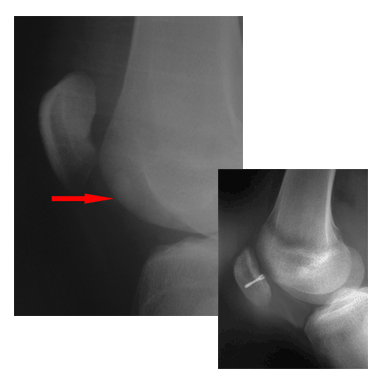
Introduction
The patented Tru-Pull® Advanced System and the Hinged Tru-Pull® Advanced System patella braces are designed to exert a dynamic pull on the patella during knee flexion and extension.
Indications
• Ultimate support for patellofemoral malalignment, subluxation and dislocations.
• in the hinged version aluminum hinges add medial/lateral support and control of knee hyperextension.
Information on Ordering
How do you avoid a mistake when ordering for your patient?
Choose the right size by marking the mid point of the patella with the patient standing in the schuss position. Measure the circumference of the thigh at 15cm above this point.
Before you choose from the drop down list write down your patient's side and size.
x=1=XS=33-39 cm
x=2=S=39-47 cm
x=3=M=47-53 cm
x=4=L=53-60 cm
x=5=XL=60-67 cm
x=6=XXL=67-75 cm
x=7=XXXL=75-82.5 cm
Tip on the use of drop down menus
After you have chosen, click off the menu and unbold the choice before you roll your mouse wheel because you might inadvertantly change your choice with the roll of the wheel.
Innovations
• Elastomeric pull device, with pull straps above and below the patella, has a rubber band type effect providing a strong dynamic pull on the patella as the knee extends.
• Independent anchors prevent rotation of the brace and provide a "True" and consistent pull on the patella to avoid lateral subluxation.
• Trimable adjustable buttress allows for versatility of contact area.
• Choice of 1/4" and 3/8" buttresses provided with the brace to give the patient the leverage they require.
• Breathable material makes the brace light and comfortable.
• New unique materials give it a modern nonmedical look.
• Ease of application leads to excellent patient compliance.
Patella Dislocation
Sports injury specialist John Hardy told OrthopaedicsandTrauma.com that patella dislocation was an injury he saw commonly in teenagers. John is a Consultant Knee Surgeon in London and Bristol in the UK. He told OrthopaedicsandTrauma.com: "I see many patients with patella dislocation who have been inadequately assessed following this injury. Aproximately 5% of all patella dislocations are associated with an osteochondral fracture usually involving the patella but ocassionally the femur."
He said: "To miss an osteochondral fracture after dislocation is tragic. This is because those injuries that are large or in a crucial position within the knee will go on to cause osteoarthritis. The doctor or physiotherapist that misses this complication is condeming the patient to osteoarthritis of the patellofemoral joint within 20 years".
John said: "To avoid missing this complication take a careful history noting when the dislocation took place, how long it took for reduction and how it was reduced. Ask about the symptoms of an effusion (swelling). Did it occur within 24 hours or did it take longer to appear? When examining the knee a tense effusion is suggestive of haemolipoarthrosis. Look for tenderness of the lateral femoral condyle or lateral patella facet. Look for bruising and tenderness in the region of the medial retanaculum".
The minimum set of radiographs should include an AP, Lateral and skyline patella. A high index of suspicion for osteochondral injury should be adopted in all dislocations and the patient should be referred to an Orthopaedic and Trauma Surgeon for additional assessemnt and an MRI scan of the knee.
John said: "Osteochondral injuries can be replaced and fixed using a miniature screw by keyhole surgery (as haxs benefitted the patient in the picture on the left) in the early period following the injury with a good chance of preventing later osteoarthirtis".